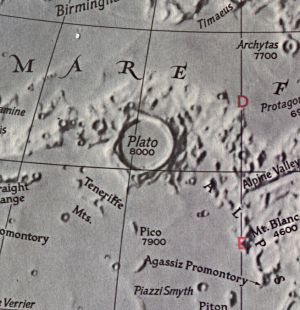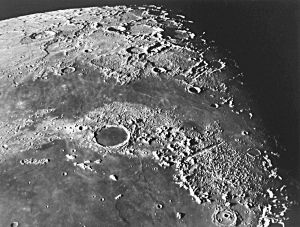Plato Sunrise Ray
Initial Reports
 |
I saw a very interesting triple sunrise ray in the crater Plato the evening of June 7th, 2003 June from Palo Alto, CA. Here is a copy of the relevant part of an observing report that I posted to our Bay Area astronomy group at the time. The three simultaneous sunrise rays, one of them shining right across two of the craterlets in the floor of Plato, made one of the most beautiful sunrise effects I have seen on the moon. I did not see Plato listed on your web site, so thought you might be interested in this report. Best regards, David Kingsley
|
Evening of June 7th, 2003:
"At the opposite end of the terminator, near the north of the moon, the sunrise over Plato was spectacular. When I first looked around 9:25 pm PDT or so, I noticed that there were two thin shafts of light extending as parallel sunrise rays across the floor of the crater. The larger one shown right across two of the small craterlets on the floor of Plato, plucking them out of the darkness. By 9:45 PDT, a third sunrise ray was evident, making a third flashlight beam across the otherwise dark floor. Each shaft of light varied in thickness and position. Although each began near the center of the crater, and extended in a shaft of light to the western wall, it was clear that each was positioned in line with a gap or notch in the eastern wall of Plato. Sun shining through such gaps can produce dramatic rays near sunrise and sunset (see http://www.lunar-occultations.com/rlo/rays/rays.htm for other known lunar rays and times to observe them at various locations in the moon). I have seen many lunar rays before, but three sunrise rays all at once in a crater like Plato made a grand sight. I sketched a few stages as the rays gradually broadened and joined as the sun rose higher and higher over the eastern wall. The fun ended when the marine layer arrived in Palo Alto around 10:45 pm or so.
Observer: David Kingsley
Equipment: Starmaster 7 inch Dobsonian, 8-24 mm zoom eyepiece with 2x barlow,
approximate magnification used for most of observation: 240x
Location: Stanford CA
Times: Double sunrise ray first noticed in Plato seen at 4:25 UT, June 8, 2003
Third parallel thin ray appears between other two by 4:45 UT, June 8, 2003 (sketch 1)
All 3 rays wider by 5:25 UT (sketch 2). Clouded out by 5:45 UT June 8th, 2003.
I took a quick digital camera image of the 2 quick sketches that I scribbled at the time, and posted it to a photoaccess web site. See: http://www.photoaccess.com/share/guest.jsp?ID=AF131A292E6&cb=PA
South is up. The first sketch was done about 4:45 UT June 8. Note that the northern most sunrise ray stretches across the doublet craterlets that are visible on a night of good seeing in the floor of Plato. The middle sunrise ray is the thinnest of the three, and had not been visible at 4:25 UT when I first noticed the southern most and northern most ray.
Second sketch done about 5:25 UT, when all three rays had widened considerably.
The Initial Predictions, Using Data in Original Reporting
Site Longitude = +122.160
Site Latitude = +37.440
Reproducing Lighting For: 2003/6/8 at 04:25 U.T.
Desired Solar Altitude = +1.118(Rising), Azimuth = +90.681
Feature = plato
Feature Longitude: = -9.300
Feature Latitude: = +51.600
Average Co-longitude = 11.101
Moon's Altitude Restricted = N
In the Time column, D=Daylight, T=Twilight
---- Moon's ---- -- Earth's --
Topocentric Topocentric -------- Sun's --------
UT Date Time Alt° Semi-Diam'' Long° Lat° Colong° Lat° Azim°
2003/06/08 04:25T +52.080 971.11 -6.217 -5.691 010.528 +0.453 +90.681
Crater Description:
Plato: -100,+782, A beautiful walled plain, familiar to every observer, and situated in the bright mountainous region separating the Maria Imbrium and Frigoris. The floor, which is 60 miles in diameter, is of a dark steel-grey tint, in strong contrast to the bright surrounding walls, and the formation is distinctly visible under any illumination.....and Webb records parallel beams of light over the floor at sunrise, seen long be by Bianchini. (Wilkins and Moore, The Moon, Faber and Faber, 1955)
Historical Reference: J. Adams (Eng. Mech., No.2374) noted on two occasions near sunrise, when the interior was filled with shadow, that two beams of light traversed two-thirds of the floor from the W wall resembling searchlights; they were parallel and well defined, and had the appearance of passing through a slight vapour resting on the surface.(Celestial Objects for Common Telescopes, Rev. T.W. Webb, Vol 1, page 164, Dover Publications, 1962) (the W wall that was described, was before the IAU switch from the classical to modern orientation. Thus the observing report by Adams stating it was on the west wall, for modern orientation, makes the observation on the eastern wall.)


Return to Home or use your browser back button


